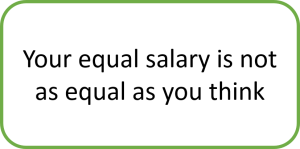Archive for April, 2016
If you are struggling with your toxic work environment – good
If you are struggling with your toxic work environment – good. 
I’m sorry that you’re in a negative work situation, but the fact that you’re struggling with it is positive.
If you are resistant when your management instructs you to take actions that are bad for customers or waste shareholder money – good. You care about doing the right thing.
If you are caught between the need to speak up about workplace bullying and the need to keep your paycheck and healthcare benefits – good. Your ethics are showing.
If the subtle, persistent discrimination against certain employees leaves you feeling drained – good. Your body itself is signaling that you are in a dangerous environment.
I am sorry that you are in a job that harms your wellbeing. However, I am glad that you are reacting negatively to a noxious job situation. Your struggle reflects your morality and your desire for fairness. You have integrity. You are in touch with human decency.
I am not worried about your humanity.
I am worried about the other people, the ones who succeed in toxic work environments.
Employees who heartily laugh along with their manager’s discriminatory jokes and respond positively when others are harassed are encouraging this behavior to persist.
Employees that willingly support management decisions that waste time and money are also guilty of wasting time and money.
Employees that unscrupulous managers rely on to support their unethical tactics are also behaving unethically.
People that thrive in toxic work environments perpetuate them. They care more about advancing their careers than they care about integrity.
So, if you are struggling to survive in a toxic work environment – good.
I hope that you advocate for change that improves the situation for you and your coworkers. If that is not possible, save yourself and change jobs before you sink into a pit of stress, depression or low self-esteem.
Most importantly: I hope you keep your integrity.
Your Equal Salary is Not as Equal as You Think
 April 12th was National Equal Pay Day.
April 12th was National Equal Pay Day.
On April 11th, Microsoft posted a blog that indicated salary equity across gender and race. I applaud Microsoft and other organizations that publish their salary data. This transparency is a great first step.
It would be tempting to conclude from the information provided that there is pay equity and move on. However, salary data is not the whole story and it does not mean that there is actual pay equity.
Let’s look at the statements published on Microsoft’s blog:
“99.8 cents earned by women for every $1 earned by men with the same job title and level in the U.S.” and “$1.00 earned by racial/ethnic minorities for every $1 earned by Caucasian employees with the same job title and level in the U.S.”.
The key words are “same job title and level.”
In many organizations people can have the same job title and the same job responsibilities, but be in different pay levels. As a fictitious example, let’s take the title “Project Manager”. This is not the same as job ladders that start with Product Coordinator, move to Project Manager, then Senior Project Manager, Lead Project Manager, Project Director, and so forth. For the title Project Manager alone, there may be multiple pay bands – say level 15, 16 and 17, with the higher levels earning larger salaries and potential bonuses.
This is the first area where pay equity breaks down quickly. Let’s look at three fictitious employees:
- Employee A is a white man in pay level 17 with a salary of $80,000
- Employee B is a white woman in pay level 16 with a salary of $70,000
- Employee C is a black man in pay level 15 with a salary of $60,000
All three of these employees may be performing the exact same job duties, but Employee A has a higher salary and may also have a larger bonus, raise, and other compensation awards.
If it seems confusing how employees performing the exact same job may be in different pay levels, here is an example that is parallel to how many organizations function: consider a company that manufactures printer paper. In a team of Project Managers, Employee A is responsible for paper with recycled content, Employee B is responsible for premium paper, and Employee C is responsible for multi-colored printer paper. They all have the same day-to-day job duties and their performance can be measured in the same ways.
Employers can justify employees doing the same jobs at different pay levels by claiming differences in work experience or subjective differences in skills.
Compiling data to determine salary equity by job role vs. level is straightforward. An employer only needs to compare the data for each job title at each pay level. What is the race/ethnicity and gender breakdown for each? Let’s say there are 300 employees in each of the Project Manager pay levels from the example above. If there are 25 women in level 17 and 250 women in level 15 – you don’t have pay equity.
Bonuses and awards are another area where compensation inequity exists. People performing the same job, whether in the same salary level or not, often receive different compensation in the form of cash awards, stock awards or options, and non-cash awards such as trips and gifts of products or services.
Raises and promotions can also be inequitable. Are employees of all genders and ethnicities receiving the same percentage of salary increases? Are they promoted with the same frequency?
Publishing salary data is a critical first step. Now let’s see companies publish the gender and race/ethnicity data for:
- The same job titles at different pay levels
- The dollar value of bonuses and awards
- Raises and promotion frequency
When this data is published then it will be clear if an organization has pay equity or not. Until then, let’s remember that the salary data by pay level is only one compensation metric and it is not the whole truth.

Recent Comments